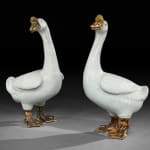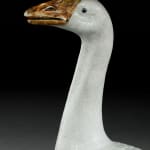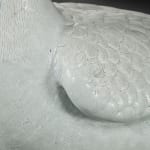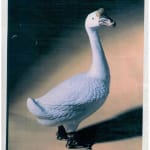A PAIR OF WHITE ENAMELLED PORCELAIN FIGURES OF GEESE
Further images
Provenance
The Ionides Collection, Buxted Park, Oxford
The Property of the late The Hon. Mrs Nellie Ionides, Sotheby’s, 18 February 1964, lot 273
Literature
COMPARE:
The Copeland Collection, illustrated W. R. Sargent, The Copeland Collection: Chinese and Japanese Ceramic Figures (Salem, 1991), cat. no. 119, p. 238-9, a similar single goose
David Howard and John Ayers, China for the West, vol. 2 (London & New York, 1978), no. 611, p. 587, for a smaller porcelain model of a goose
Publications
Victor Rienaecker, ‘Fantasies of Chinese Ceramic Art’,Country Life Annual, 1956, pl. 3
This pair of porcelain figures of geese, made during the third quarter of the eighteenth century, stand 63 and 65 cm tall. The bodies are covered in white enamel over the glaze and the bills and feet in contrasting orange-brown and yellow-green.
The figures are beautifully and realistically modelled, possessed of a true sense of life and animation, from the bright and alert eyes and the elegantly postured necks, to the wings held closely to the bodies, the lively upturning tails and the stout legs and feet. The feathery texture of the surface is beautifully created, likely largely accomplished in the mould but with the fine incised detail suggesting the individual feathers added when the clay was hard but still pliable. The bulbous protrusion on the forehead, which is particular to the Chinese goose, of each bird is coated in a translucent green-yellow enamel, has run in firing.
Wild geese symbolize conjugal devotion in Chinese culture, as they are said to mate for life and fly in pairs.1 The animal (ge) is also the symbol of the third degree in the civil rank of the Ming and Qing dynasties. The present two birds, in their graceful majesty, represent this twin message of fidelity and service.
Freestanding geese among eighteenth-century Chinese porcelain birds are rare but the present figures are an extreme rarity. A similar bird is in the Copeland Collection. The figure was illustrated in the catalogue produced by the Peabody Essex Museum, Salem where the author notes the ‘over a dozen stilt marks on the underside of the thick-walled body, beneath the breast and under the tail feathers, attest[ing] to the difficult of firing so massive a piece [61cm].’2 Another figure of a goose, though smaller, is illustrated by Howard and Ayers (1978) and described as ‘a rare model’.3
The present figures were illustrated by Victor Rienaecker in a 1956 article for Country Life Annual and identified for particular comment, being described as ‘probably unique’.4 The author also noted the craftsman’s ‘remarkable...observation of these birds and the skill with which certain technical difficulties have been surmounted’.5
1 C. A. S. Williams, Outlines of Chinese Symbolism and Art Motives (New York, 1978), p. 216-17
2 W. R. Sargent, The Copeland Collection: Chinese and Japanese Ceramic Figures (Salem, 1991), cat. no. 119, p. 238-9
3 David Howard and John Ayers, China for the West, vol. 2 (London and New York, 1978), no. 611, p. 587
4 Victor Rienaecker, ‘Fantasies of Chinese Ceramic Art’, Country Life Annual (1956), pp. 60-1, fig. 3
5 Ibid., p. 61









